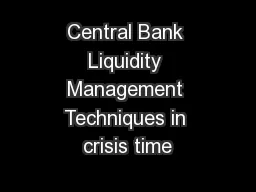

Bank of England BOE 20072010 Yonca Kumsar 1 Topics to cover 1Monetary Policy of BOE Interest Rate Quantitative Easing 2 Reserve Requirements 3Operational Standing Facilities 4Balance Sheets of BOE ID: 329557
Download Presentation The PPT/PDF document "Central Bank Liquidity Management Techni..." is the property of its rightful owner. Permission is granted to download and print the materials on this web site for personal, non-commercial use only, and to display it on your personal computer provided you do not modify the materials and that you retain all copyright notices contained in the materials. By downloading content from our website, you accept the terms of this agreement.
Slide1
Central Bank Liquidity Management Techniques in crisis times
Bank of England (BOE)2007-2010
Yonca Kumsar
1Slide2
Topics to cover :1.Monetary Policy of BOE
Interest RateQuantitative Easing2.Reserve Requirements 3.Operational Standing Facilities
4.Balance Sheets of BOE
2Slide3
1.Monetary Policy Operations
Monetary Policy Committee decides on Bank Rate In March 2009 MPC announced it starts to inject money directly into the economy by purchasing assets, known as
Quantitative EasingWhy ? In recession you cant lower interest rates below zero, then quantitative easing is used to support demand.BOE reduced Bank Rate by %0.5 to %0.5 and announced
£75 Billion Asset Purchase Programme
(
5 March 2009)
3Slide4
Interest Rates
Bank Rate: interest rate which bank lends to financial institutionsSONIA: Sterling Overnight Interbank Average rate
The Bank seeks to meet the inflation target(%2) by setting
Bank rate.In crisis: Bank rate is lowered to prevent contraction in the economy.
BOE reduced bank rate by 0.5 to %0.5. (March 2009)
4Slide5
Quantitative EasingI
n Jan2009, Asset Purchase Facility (APF) is authorised to buy high-quality assets
Purchase of assets are financed by the Bank creating money
In 5 March, MPC is authorised
to
use the APF for monetary policy
purpose
In crisis:
BOE announced
£75
Billion Asset Purchase
Program
e
5Slide6
6Slide7
2.Reserve Requirements
voluntary reserve ratio system, with no minimum reserve requirementreserves averaged over a monthly
maintenance period during which they are remunerated at Bank Rate
How can we explain these changes in average cash reserve ratio across the entire United Kingdom banking system
?
*
Country
1968
1978
1988
1998
2010
United Kingdom
20.5
15.9
5.0
3.1
43.1
7Slide8
Answer: In 2010 it was very high, with a 43.1% average this
reflects the impact of Quantitative Easing . From 1968 to 1998
it has been declining for many years
8Slide9
3.Operational Standing Facilities
Aim : to prevent money market rates moving away from Bank rateCorridor is symmetric with the deposit rate of 25bps below Bank Rate and the lending rate 25bps above Bank Rate.Banks are encouraged to transfer colleteral into the Bank
They have weekly intermeetings.
9Slide10
Symmetric Corridor Approach
10Slide11
In crisis times:But , In March 2009 : deposit rate was set to zero and lending rate to 25bps above Bank rate.
Also , they enlarged their colleteral demand to be more productive.
11Slide12
4.Balance Sheets of BOE
Why do Balance sheet percentages of annual nominal GDP increase after crisis times ?
12Slide13
Balance Sheet as % of GDP
It reflects an expansion of both the Bank’s liquidity
insurance operations, and more recently the addition of asset
purchases as an operating objective of the Monetary Policy Committee.
13Slide14
Assets :
14Slide15
Liabilities:
15Slide16
In Crisis:Dollar
reverse repo operations increased , because Federal Reserve Bank of New York provided $ after Lehman Bankruptcy and in return BOE lended sterling
In case of long term need of liquidity long term reverse repos increased.Loan to asset purchase facility : Quantitative
easing
16Slide17
Leanness Indicator :When AF- BN is zero , when
Balance Sheet only displays MPI , than BS is leanIndicator :
1-(AF in assets+AF in liab –BN) /( 2* BS Length)In crisis: BN remained almost same but since AF as FX and assets increased, leanness decreased.
17Slide18
BS pre and after crisis
18Slide19
Thank you!19